Exclusive Recipes from ‘Bistro’ by Laura Washburn Hutton
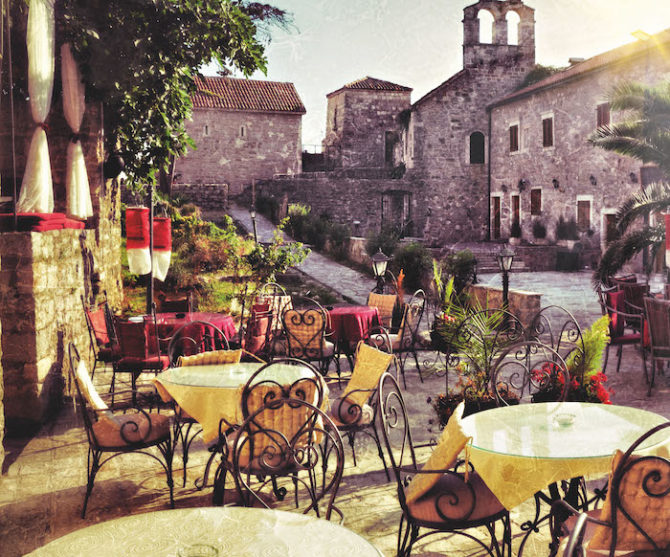
In her book Bistro, Laura Washburn Hutton explores the enduring pleasure of hearty, traditional French cooking as enjoyed in small, intimate and welcoming bistros around the country. Try these delicious, uncomplicated dishes at home!
Recipe excerpts below from ‘Bistro: Classic French Dishes to Cook and Enjoy at Home.’ By Laura Washburn Hutton. Published by Ryland Peters & Small, £9.99. Recipe images by Martin Brigdale.
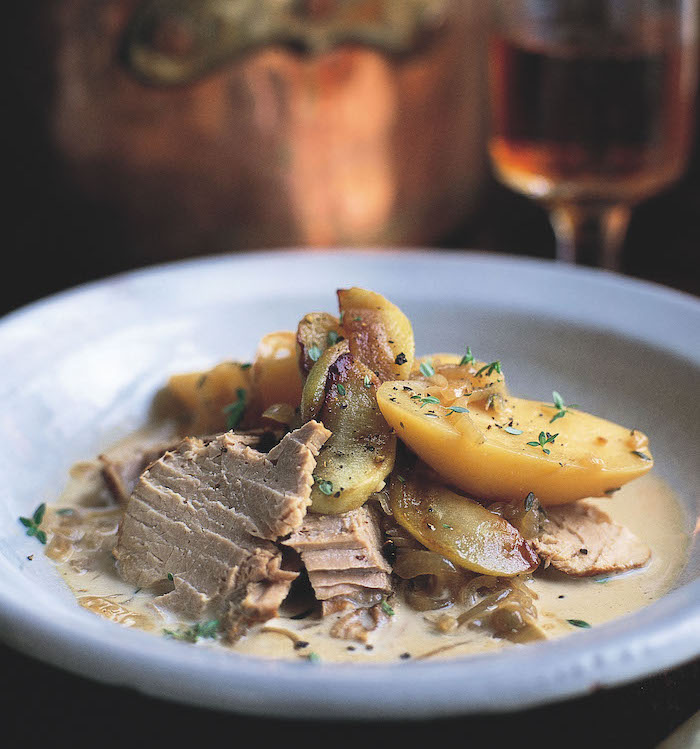
Photo credit © Martin Brigdale, Bistro: Classic French Dishes to Cook and Enjoy at Home.
PORK IN CIDER WITH POTATOES AND APPLES
If it has apples and cream, then it must be from Normandy. The cider is a good clue as well, and it provides a luxuriously rich sauce for the long-simmered pork. Unlike recipes from more southerly realms, this is subtle and delicate, but no less powerful for its discretion. A good dish for all the family, as children (and adults) enjoy sweet things to accompany their meat. Serve with the cider used in cooking, or a red wine from the Loire.
Serves 4 | Temperature: 150°C/300°F fan (Gas 2)
INGREDIENTS
- 30g unsalted butter
- 2 onions, sliced
- 1 tablespoon sunflower oil
- 1 pork middle leg roast, about 1.75kg
- 1.5 litres dry cider
2 sprigs of thyme - 800g new potatoes, peeled and halved lengthways
- 125 ml double cream
- Coarse sea salt and freshly ground black pepper
Apples
- 60g unsalted butter
- 5 tart apples, such as Braeburn or Cox’s, peeled, cored and sliced
- A large flame-proof casserole
1 Preheat the oven to 150°C (300°F) Gas Mark 2.
2 Melt the butter in a large flame-proof casserole. Add the onions and cook gently for about 5 minutes, until softened but not browned. Remove the onions.
3 Add the oil, increase the heat, add the pork and cook until browned all over. Remove and season well with salt and pepper.
4 Add some of the cider to the casserole, heat and scrape the bottom of the pan. Return the meat, onions, remaining cider and thyme. Season lightly and bring to the boil. Boil for 1 minute, skim off any foam that rises to the surface, then reduce the heat, cover and cook in the preheated oven for 4 hours. Turn the pork regularly throughout this time and taste and adjust the seasoning half-way through the cooking time.
5 One hour before the end of the cooking time, add the potatoes and continue cooking.
6 Remove from the oven, transfer the pork and potatoes to a plate and cover with foil to keep it warm.
7 Cook the sauce over high heat for 10–15 minutes to reduce slightly. Taste and adjust the seasoning.
8 Meanwhile, to cook the apples, melt the butter in a large frying pan, add the apples and cook over high heat for 5–10 minutes, until browned and tender. Do not crowd the pan; use 2 pans if necessary.
TO SERVE
1 Slice the pork and arrange on plates with the potatoes and apples.
2 Stir the cream into the sauce and serve immediately.
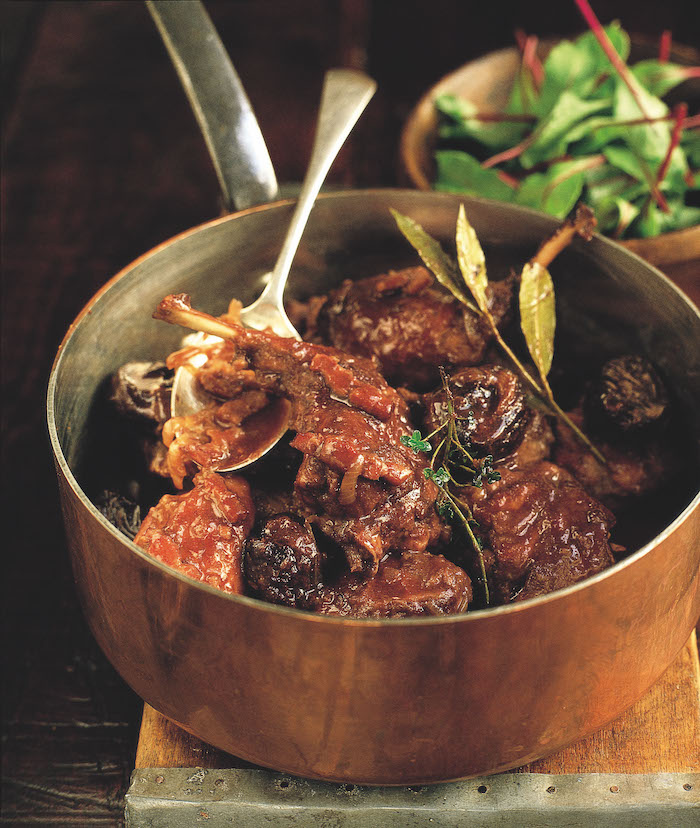
Photo credit © Martin Brigdale, Bistro: Classic French Dishes to Cook and Enjoy at Home.
RABBIT WITH PRUNES
Rabbit and prunes don’t really have a season, but this somehow seems autumnal, just the thing when the days are getting shorter and cooler, and it’s nice to fill the house with appetising aromas. A more apt name would be Drunken Rabbit, because there is so much wine, Cognac and port. But prunes it is, and they do play a vital part, adding a pleasant sweetness to the rich, velvety sauce and salty bacon lardons. Serve it with fresh pasta tossed in butter – tagliatelle is ideal. Chicken can be substituted for the rabbit, but don’t cook it for as long.
Serves 4
INGREDIENTS
- 1 rabbit, cut into 7–8 pieces
- 2 tablespoons sunflower oil
- 30g unsalted butter2 onions, halved and sliced
- 200g bacon lardons
- About 100g plain flour
- 125 ml port
- 400g plump prunes, preferably French
- 1 tablespoon crème fraîche
- Coarse sea salt and freshly ground black pepper
- Tagliatelle, to serve
Marinade
- 1 onion, chopped
- 1 carrot, chopped
- 2 garlic cloves, crushed
- 2 sprigs of thyme
- 1 fresh bay leaf
- 750-ml bottle red wine
- 250 ml Cognac
- A few black or green peppercorns
- A large flame-proof casserole
1 One day before serving, mix all the marinade ingredients in a non-reactive bowl. Add the rabbit pieces, cover and refrigerate overnight.
2 When ready to cook, remove the rabbit from the marinade, strain the liquid and reserve. Discard all the vegetables but keep the thyme and bayleaf. Pat the rabbit pieces dry with kitchen paper.
3 Heat 1 tablespoon of the oil and half the butter in a large flame-proof casserole. Add the onions and bacon lardons and cook over high heat for 5 minutes, until brown. Remove from the casserole and set aside.
4 Put the flour on a plate and add the rabbit pieces, turning to coat lightly. Add the remaining oil and butter to the casserole and heat. When sizzling, put the rabbit pieces in the casserole and brown all over. Pour in the strained marinating liquid, bacon and onion mixture and port. Add the reserved thyme and bay leaf and season with salt and pepper. Bring to the boil, skim off the foam, then lower the heat, cover and simmer for 45 minutes. Season to taste.
5 Transfer the rabbit pieces to a plate, add the prunes, increase the heat and cook the sauce for 10–15 minutes more, until thickened. Stir in the crème fraîche, return the rabbit to the casserole and heat just to warm through; do not boil. Serve immediately with tagliatelle.
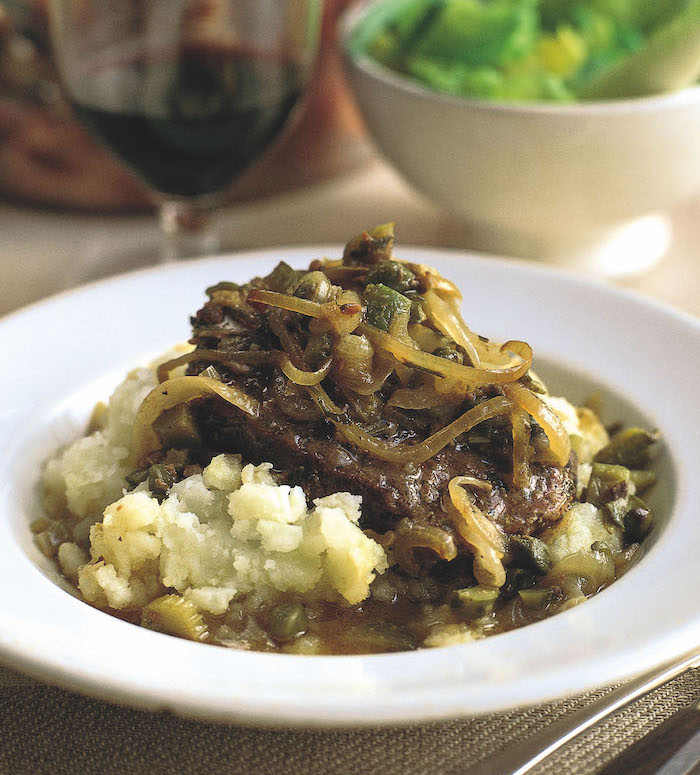
Photo credit © Martin Brigdale, Bistro: Classic French Dishes to Cook and Enjoy at Home.
BRAISED STEAK WITH ANCHOVIES AND CAPERS
The sailors who used to guide barges up and down the Rhône, from Arles to Lyon, were lucky men indeed. They invented this dish and, I assume, ate it often. If I were having my last supper, this would be it, with mashed potatoes, a green salad and a good red Rhône wine.
Serves 4 – 6 | Temperature: 150°C/300°F fan (Gas 2)
- 4 thick rump steaks, about 300g each
- 4 onions, halved and sliced
- 3 tablespoons capers, drained
- 12 French cornichons, chopped
- 10 anchovy fillets packed in oil, finely chopped
- 1 tablespoon plain flour
- 3 tablespoons red wine vinegar
Marinade
- 150 ml olive oil
- 8 garlic cloves, crushed
- A small handful of flat-leaf parsley, chopped
- 1 teaspoon coarsely ground black pepper
- 1 fresh bay leaf
- A sprig of thyme
- 1 inner celery stick, with leaves
- A large casserole dish
1 One day before serving, mix all of the marinade ingredients together in a shallow non-reactive dish. Add the steaks and turn to coat well with the mixture. Cover with cling film and refrigerate overnight, turning at least twice.
2 Preheat the oven to 150°C (300°F) Gas 2.
3 Put the onions, capers and cornichons in a bowl and toss well. Put the anchovies and flour in a small bowl and blend well. Remove the meat from the marinade and set aside. Stir the anchovies and vinegar into the marinade.
4 Put one-third of the onion mixture in the casserole and put 2 steaks on top, side by side. Spoon in half of the marinade, spreading it over the meat. Top with half the remaining onion mixture, then the remaining steaks. Spoon over the rest of the marinade and top with the rest of the onion mixture.
5 Pour in about 250 ml water. Cut a piece of baking parchment to about the diameter of the casserole and put this on top of the onions to help seal in all the juices. Cover with the lid and cook in the preheated oven for 3 hours. Serve immediately with mashed potatoes and a green salad.
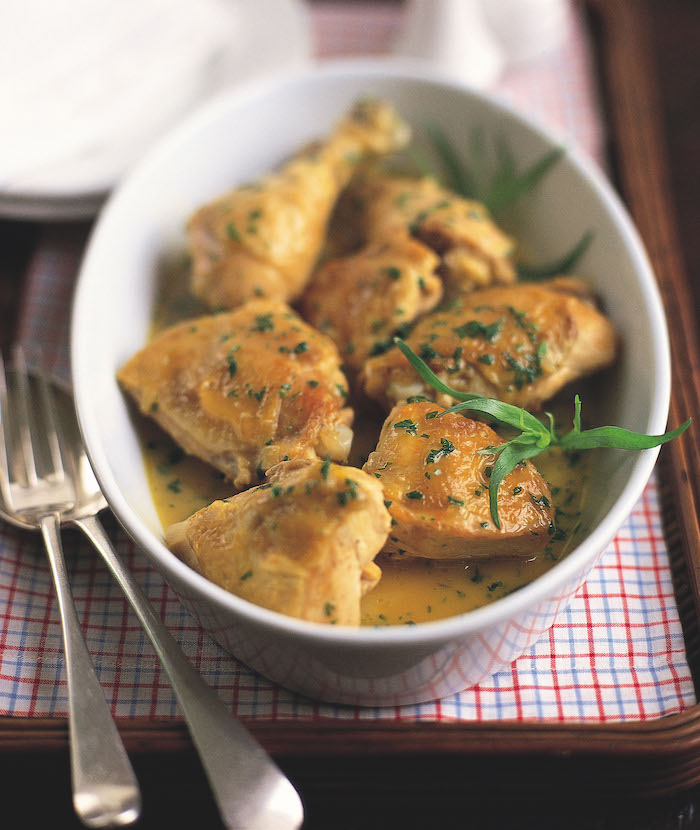
Photo credit © Martin Brigdale, Bistro: Classic French Dishes to Cook and Enjoy at Home.
CHICKEN WITH TARRAGON
Poulet sauté à l’estragon.
A dish without a region, this is served pretty much all over France, in homes as well as restaurants. It’s quick to make, if you get your butcher to cut up the chicken, and the flavour of tarragon lifts this out of the ordinary. Make this dish midweek and you’ll have a lovely supper in under an hour, or serve it for your next dinner party and it will seem as if you slaved away all day. A red Saint-Estèphe or Ladoix would be the ideal wine.
Serves 4 | Temperature: 150°C/300°F fan (Gas 2)
INGREDIENTS
- 1 tablespoon unsalted butter
- 1 tablespoon sunflower oil
- 1 free-range corn-fed chicken, about 2 kg, cut into 6–8 pieces
- 2 carrots, chopped
- 1 shallot, chopped
- A sprig of thyme
- 2–3 sprigs of flat-leaf parsley
- A bunch of tarragon
- 3 tablespoons crème fraîche
- Coarse sea salt and freshly ground black pepper
1 Melt the butter and oil in a large frying pan with a lid. Add the chicken pieces and cook for about 5 minutes, until brown. Put the browned chicken pieces on a plate and season with salt and pepper.
2 Add the carrots and shallot to the pan and cook, stirring for 1–2 minutes. Return the chicken to the pan and add water to cover half-way. Add the thyme, parsley and a few sprigs of tarragon. Cover and simmer gently for 30 minutes.
3 Meanwhile, strip the leaves from the remaining tarragon, chop them finely and set aside. Add the stems to the cooking chicken.
4 Remove the chicken from the pan and put it in a serving dish. Remove and discard the tarragon stems.
5 Increase the heat and cook the sauce until it has reduced by half. Strain and return the sauce to the pan. Stir in the crème fraîche and the chopped tarragon. Heat briefly (do not let it boil as the cream will split) and pour over the chicken. Serve immediately.
Purchase the book on Amazon, UK shipping or US shipping available.
Want to be inspired by more French foodie experiences and enjoy classic French food, wine and recipes? Head to our sister website on Taste of France here.
As seen in France Today magazine
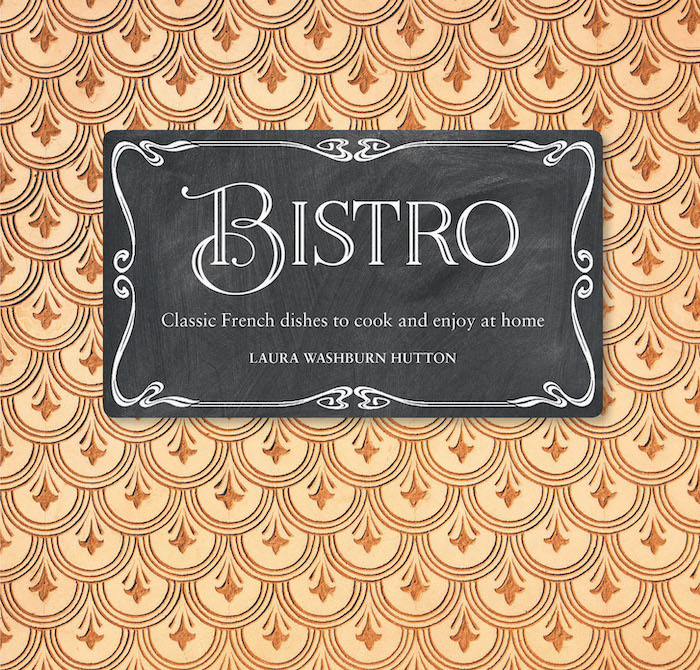
Book cover. Photo credit © Bistro: Classic French Dishes to Cook and Enjoy at Home.
Share to: Facebook Twitter LinkedIn Email
More in cooking classes, dinner, French cla
Leave a reply
Your email address will not be published. Required fields are marked *




REPLY
REPLY